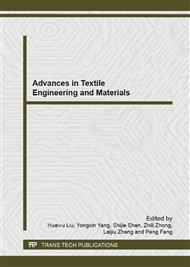p.722
p.726
p.730
p.734
p.737
p.741
p.745
p.751
p.756
Optimization Process and Characteristic Evaluations of Pro-Environmental Recycled PET Composite Geotextiles
Abstract:
Recently environmental protection have been responded to by people. In this experiment, nonwoven selvages were smashed and then secondary used to prepare water-retaining geotextiles for achieving recovery effect. The geotextiles consisted of 6D recycled high-strength PET (RPET) fibers taken from nonwoven selvages. The RPET composite geotextiles were prepared after the 1000 D high-strength PET was blended with different ratios of the RPET fibers. Afterwards, their busting strength, air permeability and porosity were mainly discussed to acquire the best blending ratio. The result shows that, the bursting strength is reinforced but the air permeability is decreased with addition of high-strength PET. The optimal blending ratio of 1000 D high-strength PET and 6D RPET is 40 %/60 % on account of comparison with strength of commercially available geotextiles.
Info:
Periodical:
Pages:
737-740
Citation:
Online since:
December 2012
Keywords:
Price:
Сopyright:
© 2013 Trans Tech Publications Ltd. All Rights Reserved
Share:
Citation:


